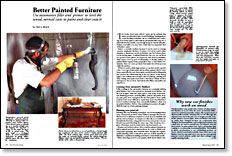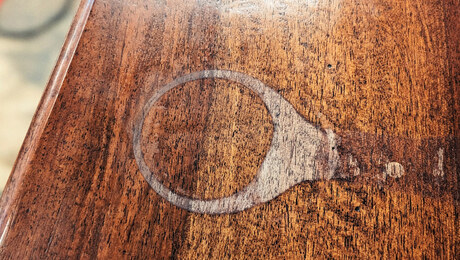Better Painted Furniture
Use automotive filler and primer to level the wood, aerosol cans to paint and clear coat it
Synopsis: Paint is a versatile finishing option; it can play up the lines in a piece, set off the wood, or salvage scrapwood. However, it cannot cover up poor workmanship or shoddy surfaces. Here, finishing chemist Chris A. Minick explains how to prepare a surface for paint and mentions products that make the process easier. He shares tips he gained from automotive finishers and why automotive products work well on wood. He talks about planning the job and preparing surfaces by not just sanding, but filling with putty, too. The article also covers painting, clear coating, and rubbing out.
If it works, don’t mess with it,” sums up the attitude that many woodworkers have toward finishing. Learning about a new finishing technique can be complicated and confusing. So it seems easier to stick with an old standby like tung oil, or stain followed by varnish, even though it may be merely adequate. If that’s your habit, you may have overlooked an important class of finishes—paint.
Paint is a versatile medium because it can be used as a design accent to emphasize the lines of a piece, or it can be used to draw attention to handsome woods in furniture. A painted finish also lets you use up those too-good-to-burn pieces of scrapwood. But don’t be mistaken. Paint cannot cover up poor workmanship or shoddy surfaces. A painted finish requires better preparation than a clear finish. Fortunately, there are some products that make the whole process relatively painless.
If I have to paint a fairly large project or one that needs a special color, I use a good latex paint and an airless sprayer. But for most items, especially the ones that require a professional-looking paint job (such as the coffee-table leg in the top photo on the facing page), I use ordinary aerosol spray cans for priming, painting and clear coating. Auto-parts stores have a marvelous variety of colors and types to choose from. And automotive fillers and putties are superb too.
Learning from automotive finishers
Folks working in the automotive industry are constantly refining paint finishes, due to the meticulous demands of car finishes. That’s the main reason I buy many of my furniture-finishing products, including fillers, primers and paints, from my auto-parts store. And given the fact that paint is more easily scratched and more difficult to repair than most clear finishes, I borrow another technique from automobile finishers: I clear coat my painted finishes. Before I buy anything for a project, though, I think through my whole painting strategy.
Planning your paint job
Painting, like any finishing technique, can be frustrating when some unexpected problem arises halfway through the process. The best way to eliminate surprises is to test all your materials and practice new techniques on scrapwood. After all, you wouldn’t cut dovetails the first time using prized wood for your project. So you should treat paint-finishing the same way. Paint decisions for a piece of furniture must be made before the first board is cut.
From Fine Woodworking #111
For the full article, download the PDF below:
Fine Woodworking Recommended Products

Odie's Oil

Osmo Polyx-Oil

Foam Brushes






















Log in or create an account to post a comment.
Sign up Log in